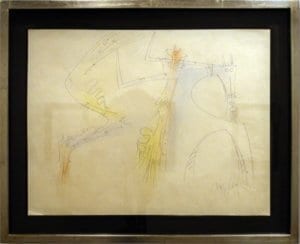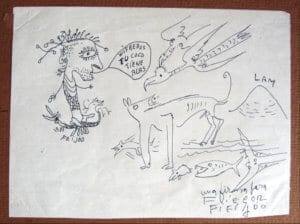José de la Fuente
Ciudad Real, Spain
 |
 |
 |
|
Figure 1. Wilfredo Lam. Untitled. Ink drawing on paper, 1947 |
Figure 2. Wilfredo Lam. Untitled. Pastel on paper, 1970. KGJ Collection, Spain |
Figure 3. Wilfredo Lam and Samuel Feijoo. Conversaciones. Ink on paper, 1981. KGJ Collection, Spain |
Epidemiology and art have met several times, but what can we learn from the surrealistic animalarium? Several of the surrealist artists used animals as symbols. However, in some cases they also provided compositions that are relevant for the study of infectious diseases.
Anaplasmosis is one of the major tick-borne diseases that affect humans (human granulocytic anaplasmosis; HGA) and animals (e.g. bovine anaplasmosis and tick-borne fever) worldwide. In humans, the pathogen causing HGA is Anaplasma phagocytophilum and the main vectors are Ixodes tick species. The most common symptoms of HGA are fever, chills, headache, and myalgias. The wide host range of A. phagocytophilum, the extensive distribution and expansion of tick vectors, and increasing host movement and human contact with infected ticks contribute to the continued emergence of enzootic HGA in several regions of the world.1,2
Wifredo Lam (Wifredo Oscar de la Concepción Lam Castilla y Mazzola; Sagua la Grande, Cuba, 1902 – París, France, 1982) is one of the surrealist artists who combined Afro-Cuban cultural heritage with a rich animalarium (Figures 1-3). In several of his pieces, humans are represented as a Güije (also known as Jigüe or Chichiricú), a form of African origin to name the goblins of the rivers, ponds, and lagoons.3
As scientists, when we look at Lam´s pieces we are reminded of the power of curiosity, which frequently gets lost during research, and ask questions that are relevant for the investigation. Lam´s visual representations translate into complex or unrecognized concepts and provide a way to better understand the epidemiology of infectious diseases such as anaplasmosis. In this way, art and science converge for the purpose of moving society forward and both benefit from the learning process.
In Lam pieces dated at different periods of his career from 1947 (Figure 1), 1970 (Figure 2), and 1981 (Figure 3), humans live together with wild and domestic animals that serve as reservoir hosts for Anaplasma species. These animals include cattle, horses, birds, rodents, and dogs, all potential hosts for the causative agent of HGA. This view clearly illustrates how the pathogen potentially disseminates through multiple vertebrate species, thus increasing the disease risks.2 Interestingly, the inclusion of the birds also illustrates the role that these animals play in the dissemination of tick species that are potential vectors for the pathogen.1 But what can we learn from the fishes included in one of the pieces (Figure 3)? Fishes are not recognized as a host for Anaplasma species, but are involved in the life cycle of Neorickettsia that are also members of the order Rickettsiales, family, Anaplasmataceae. For example, the zoonotic cycle of Neorickettsia sennetsu encompasses infecting trematodes that parasitize fish, and vertebrates that eat uncooked fish containing infected flukes may become infected with this pathogen.4
These pieces also serve to illustrate that host-vector-pathogen interactions evolved as conflict and cooperation.5 This arms race not only affects players through pathogen infection and immune responses, but also may provide benefits. It has been recently recognized that ticks are associated with the allergy to red meat, a disease that occurs in humans because during evolution humans lost the ability to synthetize the carbohydrate α-Gal that resulted in the capacity to produce high antibody titers against α-Gal.6 While the IgE antibodies against α-Gal may result in allergic reactions, IgM/IgG antibodies may help by protecting against infectious diseases such as tuberculosis or malaria caused by pathogens that contain α-Gal on their surface.7 Interestingly, other vertebrates such as birds and fishes present in Lam pieces are also able to produce antibodies against α-Gal, posting a question about the benefits that may be associated with the evolution of α-Gal synthesis.
Taken together, Lam pieces clearly illustrate the complex epidemiological network of anaplasmosis and contribute to communicating this information to the general public. By recognizing the hosts and tick vectors associated with these diseases, the society can implement measures to limit or decrease the risks of infection. This is another example of the important link between art and science.
References
- de la Fuente, J., Estrada-Peña, A., Cabezas-Cruz, A., Brey, R. 2015. Flying ticks: anciently evolved associations that constitute a risk of infectious disease spread. Parasites & Vectors 8: 538. https://www.ncbi.nlm.nih.gov/pmc/articles/PMC4607018/
- Estrada-Peña, A., de la Fuente, J., Ostfeld, R.S., Cabezas-Cruz, A. 2015. Interactions between tick and transmitted pathogens evolved to minimise competition through nested and coherent networks. Scientific Reports 5: 10361. https://www.ncbi.nlm.nih.gov/pmc/articles/PMC4438610/
- Ortiz Fernández, F. History of a Cuban struggle against the demons (“Historia de una pelea cubana contra los demonios”). Universidad Central de Las Villas, Cuba.
- Paris, D.H., Day, N.P.J. 2014. 22 – Tropical rickettsial infections. Manson´s Tropical Infectious Diseases (Twenty-third Edition). Editor(s): Jeremy Farrar, Peter J. Hotez, Thomas Junghanss, Gagandeep Kang, David Lalloo, Nicholas J. White. W.B. Saunders, pp. 273-291.
- de la Fuente, J., Villar, M., Cabezas-Cruz, A., Estrada-Peña, A., Ayllón, N., Alberdi, P. 2016. Tick-host-pathogen interactions: conflict and cooperation. PLoS Pathogens 12(4): e1005488. https://www.ncbi.nlm.nih.gov/pmc/articles/PMC4839629/
- Velasquez-Manoff, M. 2018. What the Mystery of the Tick-Borne Meat Allergy Could Reveal. The New York Times Magazine, July 24, 2018. https://www.nytimes.com/2018/07/24/magazine/what-the-mystery-of-the-tick-borne-meat-allergy-could-reveal.html
- Cabezas-Cruz, A., de la Fuente, J. 2017. Immunity to α-Gal: towards a single-antigen pan-vaccine to control major infectious diseases. ACS Central Science 3: 1140-1142. https://www.ncbi.nlm.nih.gov/pmc/articles/PMC5704288/
JOSE DE LA FUENTE is Professor of the Higher Council of Scientific Research (CSIC) and head of the Genomics, Proteomics & Biotechnology group at SaBio, IREC, Spain, and Adjunct Professor at the Department of Veterinary Pathobiology, Center for Veterinary Health Sciences, Oklahoma State University, U.S.A. He has over thirty years’ experience in research, education, and as Principal Investigator in research projects. His research focuses on the study of the host-vector-pathogen molecular interactions, and translation of this basic information into development of effective vaccines and other interventions for the control of infectious diseases affecting human and animal health worldwide.
Summer 2018 | Sections | Infectious Diseases

Leave a Reply